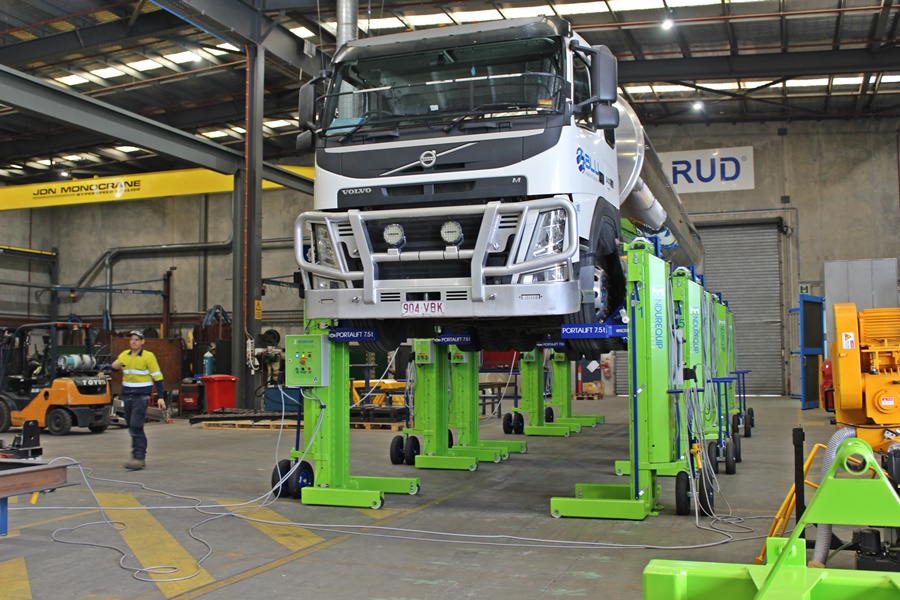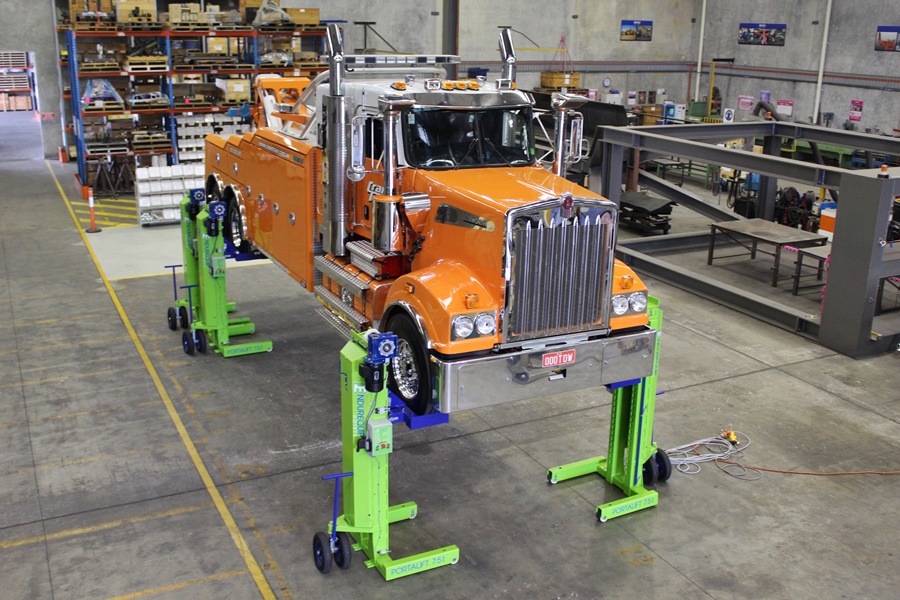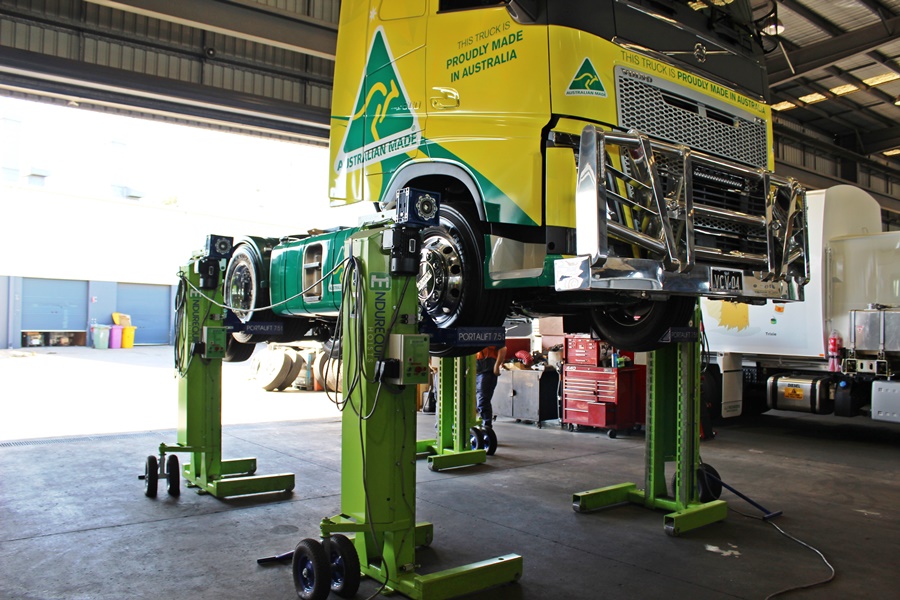Welcome aboard Australia’s leading material lifting and handling technology company.
Click below to read about us, our products, news, blog posts and everything happening at RUD in Australia and around the world.
Tradition in Dynamic Innovation.
The transition to electric vehicles (EVs) is rapidly transforming the transportation landscape, and the impact extends beyond passenger cars. Heavy-duty vehicles like trucks and buses are also going electric, bringing significant changes to the way they are maintained and repaired.
Electric Vehicles are also changing the revenue stream of workshops with fewer oil changes and seasonal inspections. In addition, EVs can be heavier than their diesel counterparts because of the significant weight of the battery, resulting in higher tyre wear rates. Electric Vehicles (EVs) can wear out tyres up to 30% faster than traditional diesel vehicles, making the need for tyre replacements more frequent.
This article explores how electric trucks and buses will change the operations of mechanical trucks and bus workshops. It also focuses on the challenges and opportunities presented by the unique undercarriage design and the adaptation required to lift these heavy vehicles.
A New Era of Service:
The transition to electric vehicles requires mechanical workshops to adapt their skillsets and equipment to cater to this new technology. Governments and councils across Australia are offering courses and support to mechanics to transition to electric vehicles. NSW is planning to phase out diesel buses by 2030, while the ACT Government procured the first zero-emission buses last year. Brisbane Council is working with the Queensland Government to introduce their Zero Emission Vehicle Strategy by introducing zero-emission buses starting in 2025.
While the core principles of mechanical maintenance remain the same, electric trucks and buses introduce distinct elements that necessitate adjustments in workshop operations.
High-voltage systems: Servicing electric vehicles necessitates specialised training and safety protocols to handle high-voltage (HV) batteries and electric motors. Technicians must be certified and equipped with appropriate compliance requirements to work safely with these components.
Diagnostic Tools:
Traditional diagnostic tools used on internal combustion engine vehicles are not suitable for EVs. Workshops need to invest in specialised diagnostic equipment and software specifically designed for electric powertrains.
Focus on Preventative Maintenance:
Unlike internal combustion engine vehicles with regular component wear and tear, electric vehicles experience less frequent mechanical issues. However, preventative maintenance becomes crucial to ensure optimal battery health and performance. Workshops will need to develop specialised service packages and schedules tailored to electric vehicles.
The Undercarriage Challenge: Mobile Column Hoists and Electric Vehicles
One of the most significant challenges posed by electric trucks and buses lies in their undercarriage design. Unlike traditional vehicles with engines and fuel tanks located beneath the driver's cabin, electric vehicles house their battery packs under the vehicle floor, impacting the feasibility of using lifting equipment with tyres. This is particularly relevant to mobile column lifts, which need to be modified with adaptors to be used with both electrical and diesel engine vehicles.
Some of the Challenges for Mobile Column Lifts are:
Limited access points: The placement of battery packs underneath the chassis can restrict access to the tyres with mobile column hoists. This requires a careful selection of lifting points to ensure safe and stable lifting without compromising the integrity of the battery pack or other vital components.
Weight distribution: The weight distribution of electric vehicles differs from diesel vehicles due to the placement of heavy batteries. Workshops need to ensure the hoist configuration can handle the specific weight distribution of the electric vehicle being serviced, maintaining proper stability during the lifting process.
Lifting point adaptors: Depending on the specific vehicle model and lift design, workshops might need to invest in specialised lifting point adaptors to ensure proper contact and distribution of lifting force while avoiding damage to the undercarriage or battery pack.
Embracing the Change: Opportunities for Workshops:
Despite the challenges, the transition to electric vehicles also presents opportunities for workshops to adapt and thrive:
Invest in specialised tools and equipment: Workshops can invest in specific tools and equipment designed for servicing electric vehicles, such as high-voltage diagnostic tools, battery management systems, and lifting adaptors. This allows them to offer comprehensive services for the growing electric vehicle fleet.
Develop new service packages: By offering specialised preventative maintenance and repair services tailored to electric vehicles, workshops can attract new customers and differentiate themselves from competitors.
Upskill workforce: Training existing technicians and recruiting personnel with expertise in electric vehicle technology is crucial to ensure a skilled workforce capable of servicing these vehicles safely and efficiently.
Conclusion:
The transition to electric trucks and buses requires significant adjustments from mechanical truck and bus workshops. While mobile column hoists face challenges due to the different undercarriage designs of electric vehicles, proactive workshops can adapt by investing in specialised tools, developing new service offerings, and upskilling their workforce. By embracing the change and staying at the forefront of technological advancements, workshops can ensure they are well-positioned to thrive in the evolving transportation landscape.
Without Trucks, Australia Stops! But when trucks need to go, Endurequip keeps them going!
If you want to know how the team at RUD can help you, please call 07 3809 1300 or fill out an enquiry form here.
Welcome aboard Australia’s leading material lifting and handling technology company.
Click below to read about us, our products, news, blog posts and everything happening at RUD in Australia and around the world.
Tradition in Dynamic Innovation.
Part 2 of the 2-part article. Click here to read Part 1.
Installation and maintenance tips for your 4 post truck hoist
Once you have chosen the right 4 post truck hoist for your workshop, proper installation and maintenance are crucial to ensure its optimal performance and longevity. Here are some tips to keep in mind:
Professional Commissioning It is highly recommended to have your truck hoist professionally commissioned or installed. A professional technician will ensure that the hoist is correctly positioned and safe to operate. This is essential for both safety and efficient operation.
Regular Inspections Perform regular inspections of your hoist to identify any signs of wear or damage. Check for loose bolts, hydraulic leaks, or any other issues that may affect the hoist's performance. Addressing these problems promptly can prevent more significant issues down the line.
Lubrication Proper lubrication is crucial to keep your hoist running smoothly. Follow the manufacturer's guidelines on the type and frequency of lubrication required. Regularly lubricate all moving parts, such as cables, pulleys, and bearings, to minimise friction and ensure optimal performance.
Operator Training Ensure that all workshop staff who will be operating the truck hoist are properly trained. This includes familiarising them with the hoist's controls, safety features, and operating procedures. Proper training can prevent accidents and ensure the hoist is used correctly.
By following these installation and maintenance tips, you can maximise the lifespan of your truck hoist and keep it operating at its best.

Safety precautions when operating a 4 post truck hoist
Safety should always be a top priority when operating a truck hoist. Here are some essential safety precautions to keep in mind:
Read the Manual Familiarise yourself with the manufacturer's manual and instructions before operating the hoist. Understand the safety features, controls, and operating procedures.
Inspect the Hoist Before each use, visually inspect the hoist for any signs of wear, damage, or hydraulic leaks. Check that all safety mechanisms are in place and functioning correctly.
Securely Position the Vehicle Ensure the vehicle is correctly positioned on the hoist's wheel cradles before lifting. Use wheel chocks to prevent any unintended movement.
Proper Lifting Points Identify and use the correct lifting points on the vehicle to prevent damage. Use vehicle stands to free up the hoist to lift another vehicle. Refer to the vehicle's manual for guidance.
Avoid Overloading Never exceed the weight capacity of the hoist. Overloading can lead to structural failure and accidents.
Stay Clear Keep all body parts clear of moving parts while operating the hoist. Avoid reaching under the vehicle or between the hoists.
Use Safety Locks Engage the hoist's safety locks once the vehicle is lifted to prevent any accidental lowering.
Proper Lowering Procedure Follow the manufacturer's instructions for the correct procedure to lower the vehicle safely. Avoid sudden or uncontrolled lowering.
By following these safety precautions, you can minimise the risk of accidents and ensure a safe working environment for yourself and your employees.
Without Trucks, Australia Stops! But when trucks need to go, Endurequip keeps them going!
If you want to know how the team at RUD can help you, please call 07 3809 1300 or fill out an enquiry form here.
This is a 2 part article.
If you want to increase your workshop's efficiency and make the most of your available space, an Endurequip Portalift 4 post truck hoist is a must-have piece of equipment. Designed with durability and functionality, the 4 post truck hoists can lift heavy vehicles securely and safely, allowing you to work on them efficiently.
With a 4 post truck hoist, you can maximise your workshop space by using vertical storage.
Not only does a 4 post truck hoist provide practical benefits, but it also helps to improve your overall workflow. You can save time and effort by eliminating the need for manual lifting and jacks, allowing you to work more efficiently and increase your productivity.
Investing in a high-quality 4 post truck hoist is a sound business decision for any serious workshop. It is a versatile equipment with numerous benefits, making it an essential addition to your workspace. So, take your workshop efficiency to the next level with a 4-post truck hoist and experience the difference it can make.

Benefits of using a 4 post truck hoist in your workshop
The benefits of using a 4 post truck hoist in your workshop are numerous and can significantly impact your overall efficiency. Here are some key advantages of incorporating a 4 post truck hoist into your workspace:
Increased Productivity
One of the primary benefits of using a 4 post truck hoist is the increased productivity it offers. With a hoist, you can lift heavy vehicles effortlessly, allowing you to work on them more efficiently. This saves you time and effort, enabling you to complete jobs faster and take on more projects. Maximising your productivity can increase your revenue and grow your business.
Versatility
A 4 post truck hoist is equipment that can be used for a wide range of trucks, from weighing 7.5 tonnes to up to 30 tonnes. This versatility allows you to cater to a diverse customer base, expanding your service offerings and attracting more clients. Whether you're a mechanic or a panel beater, a 4 post truck hoist allows you to work on different types of vehicles efficiently.
Improved Safety
Safety should always be a top priority in any workshop. With a 4 post truck hoist, you can ensure your and your employees' safety. These hoists are designed with robust safety features, such as locking systems and safety latches, to prevent accidents and injuries. Investing in a high-quality Endurequip Portalift hoist can provide a safe working environment for everyone in your workshop.
Cost Savings
While the initial investment in a 4 post truck hoist may seem significant, it can lead to long-term cost savings. With a hoist, you can minimise the risk of vehicle damage, as the lifting process is controlled and secure. This reduces the need for costly repairs and replacements, saving you money in the long run. A 4 post truck hoist also maximises your workshop space, eliminating the need for expensive facility expansions.

Factors to consider when choosing a 4 post truck hoist
Selecting the correct 4 post truck hoist for your workshop is crucial to maximise efficiency and productivity. Consider the following factors when making your decision:
Weight Capacity
The weight capacity of the hoist is a critical consideration. Ensure that the hoist you choose can handle the maximum weight of the vehicles you typically work with. Choosing a hoist with a higher weight capacity is always better than you currently need to accommodate any potential future requirements.
Height Clearance
The height clearance of the hoist determines how high you can lift the vehicles. Consider the maximum height clearance you require to work comfortably in your workshop.
Length
The workshop length is essential, primarily if you work with longer vehicles. Ensure the hoist's cradle is sufficient to accommodate the vehicles you typically work on. Consider any future expansion plans and changes in the types of vehicles you may work with.
Safety Features Safety should always be a top priority. Look for hoists with robust safety features such as locking systems, safety latches, and emergency stop buttons. Additionally, ensure the hoist meets all the necessary safety standards and certifications.
Reputation and Warranty
Research the manufacturer's reputation and read customer reviews before making a purchase. A reputable manufacturer will provide a warranty for their hoists, giving you peace of mind knowing that you're investing in a quality product.
Endurequip Portalift Hoists are the only Australian-Made Heavy Vehicle Hoists manufactured in Brisbane.
To be continued ...
Without Trucks, Australia Stops! But when trucks need to go, Endurequip keeps them going!
If you want to know how the team at RUD can help you, please call 07 3809 1300 or fill out an enquiry form here.